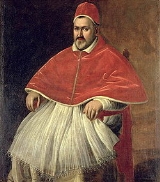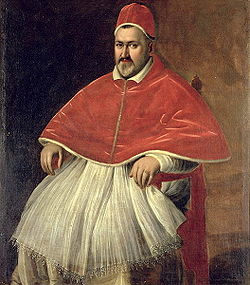
Bank of the Holy Spirit
Encyclopedia
The Bank of the Holy Spirit was a bank
founded by Pope Paul V
on December 13, 1605. The Bank was the first national bank
in Europe
(as the bank of the Papal States
), the first public deposit bank in Rome, and the oldest continuously-operating bank in Rome until its merger in 1992.
 The Bank was founded by Pope Paul V
The Bank was founded by Pope Paul V
in the Bench of S. Spirit building (which became known as the Palazzo del Banco di S. Spirito) on December 13, 1605. The construction of the building was started in 1513 by Pope Leo X
, on what became known as the "Street of the Banks." The newly founded bank provided a new source of income for the Archhospital of Santo Spirito (founded 1201), whose financial difficulties had been increasing throughout the 16th century, and in 1607 the bank began supervising the finances of the hospital, which owned the bank.
From February 20, 1606 to 1923, the Bank of the Holy Spirit provided capital for churches and hospitals constructed in Rome, and other commercial purposes. The bank lent funds to several public works projects, including the Trajan aqueduct project (begun 1608).
In 1750, Pope Benedict XIV
, known for his condemnation of usury
: Vix Pervenit
(promulgated November 1, 1745), reorganized the Bank and restricted its lending activities. In 1786, the bank became one of the first to issue paper money
during the pontificate of Pope Pius VI
.
The records of the Bank are extant in the Vatican Secret Archives
, but not in Introitus et Exitus
, the records of the Apostolic Camera
.
(IRI) of the fascist Italian government gained a controlling interest in the bank.
In the 1930s, Neapolitan
bank robbers attempting to dig into the underground vaults of the Bank accidentally discovered the skeletons of victims of a 1836 cholera
epidemic, which after archeological excavation became known as the Fontanelle
cemetery.
.
Bank
A bank is a financial institution that serves as a financial intermediary. The term "bank" may refer to one of several related types of entities:...
founded by Pope Paul V
Pope Paul V
-Theology:Paul met with Galileo Galilei in 1616 after Cardinal Bellarmine had, on his orders, warned Galileo not to hold or defend the heliocentric ideas of Copernicus. Whether there was also an order not to teach those ideas in any way has been a matter for controversy...
on December 13, 1605. The Bank was the first national bank
National bank
In banking, the term national bank carries several meanings:* especially in developing countries, a bank owned by the state* an ordinary private bank which operates nationally...
in Europe
Europe
Europe is, by convention, one of the world's seven continents. Comprising the westernmost peninsula of Eurasia, Europe is generally 'divided' from Asia to its east by the watershed divides of the Ural and Caucasus Mountains, the Ural River, the Caspian and Black Seas, and the waterways connecting...
(as the bank of the Papal States
Papal States
The Papal State, State of the Church, or Pontifical States were among the major historical states of Italy from roughly the 6th century until the Italian peninsula was unified in 1861 by the Kingdom of Piedmont-Sardinia .The Papal States comprised territories under...
), the first public deposit bank in Rome, and the oldest continuously-operating bank in Rome until its merger in 1992.
First period (1605–1923)

Pope Paul V
-Theology:Paul met with Galileo Galilei in 1616 after Cardinal Bellarmine had, on his orders, warned Galileo not to hold or defend the heliocentric ideas of Copernicus. Whether there was also an order not to teach those ideas in any way has been a matter for controversy...
in the Bench of S. Spirit building (which became known as the Palazzo del Banco di S. Spirito) on December 13, 1605. The construction of the building was started in 1513 by Pope Leo X
Pope Leo X
Pope Leo X , born Giovanni di Lorenzo de' Medici, was the Pope from 1513 to his death in 1521. He was the last non-priest to be elected Pope. He is known for granting indulgences for those who donated to reconstruct St. Peter's Basilica and his challenging of Martin Luther's 95 Theses...
, on what became known as the "Street of the Banks." The newly founded bank provided a new source of income for the Archhospital of Santo Spirito (founded 1201), whose financial difficulties had been increasing throughout the 16th century, and in 1607 the bank began supervising the finances of the hospital, which owned the bank.
From February 20, 1606 to 1923, the Bank of the Holy Spirit provided capital for churches and hospitals constructed in Rome, and other commercial purposes. The bank lent funds to several public works projects, including the Trajan aqueduct project (begun 1608).
In 1750, Pope Benedict XIV
Pope Benedict XIV
Pope Benedict XIV , born Prospero Lorenzo Lambertini, was Pope from 17 August 1740 to 3 May 1758.-Life:...
, known for his condemnation of usury
Usury
Usury Originally, when the charging of interest was still banned by Christian churches, usury simply meant the charging of interest at any rate . In countries where the charging of interest became acceptable, the term came to be used for interest above the rate allowed by law...
: Vix Pervenit
Vix Pervenit
Vix Pervenit: On Usury and Other Dishonest Profit was an encyclical, promulgated by Pope Benedict XIV on November 1, 1745, which condemned the practice of charging interest on loans as usury. Because the encyclical was addressed to the Bishops of Italy, it is generally not considered ex cathedra...
(promulgated November 1, 1745), reorganized the Bank and restricted its lending activities. In 1786, the bank became one of the first to issue paper money
Paper Money
Paper Money is the second album by the band Montrose. It was released in 1974 and was the band's last album to feature Sammy Hagar as lead vocalist.-History:...
during the pontificate of Pope Pius VI
Pope Pius VI
Pope Pius VI , born Count Giovanni Angelo Braschi, was Pope from 1775 to 1799.-Early years:Braschi was born in Cesena...
.
The records of the Bank are extant in the Vatican Secret Archives
Vatican Secret Archives
The Vatican Secret Archives , located in Vatican City, is the central repository for all of the acts promulgated by the Holy See. The Pope of the Roman Catholic Church, having primal incumbency until death, owns the archives until the next appointed Papal successor...
, but not in Introitus et Exitus
Introitus et Exitus
Introitus et Exitus Cameræ Apostolicæ is a six-hundred-and-six-volume financial record of the Apostolic Camera of the Holy See, from 1279 to 1524, located in the Vatican Secret Archives. The volumes span the reigns of thirty-two popes from Pope Nicholas III to Pope Clement VII...
, the records of the Apostolic Camera
Apostolic Camera
The Apostolic Camera, or in Latin Camera Apostolica or Apostolica Camera, is the central board of finance in the Papal administrative system, which at one time was of great importance in the government of the States of the Church, and in the administration of justice, led by the Camerlengo of the...
.
1923–92
In 1923, the Bank was reorganized as a joint-stock company. In 1935, the Istituto per la Ricostruzione IndustrialeIstituto per la Ricostruzione Industriale
The Istituto per la Ricostruzione Industriale was an Italian public company set up by the fascist government in 1933 to combat the effects of the global depression on the Italian economy...
(IRI) of the fascist Italian government gained a controlling interest in the bank.
In the 1930s, Neapolitan
Naples
Naples is a city in Southern Italy, situated on the country's west coast by the Gulf of Naples. Lying between two notable volcanic regions, Mount Vesuvius and the Phlegraean Fields, it is the capital of the region of Campania and of the province of Naples...
bank robbers attempting to dig into the underground vaults of the Bank accidentally discovered the skeletons of victims of a 1836 cholera
Cholera
Cholera is an infection of the small intestine that is caused by the bacterium Vibrio cholerae. The main symptoms are profuse watery diarrhea and vomiting. Transmission occurs primarily by drinking or eating water or food that has been contaminated by the diarrhea of an infected person or the feces...
epidemic, which after archeological excavation became known as the Fontanelle
Fontanelle (disambiguation)
A fontanelle is a soft spot in the skull of a baby where the bones of the skull have not yet knit together, but normally will do so in time.Fontanelle may also refer to:*Fontanelle, Iowa, a city in the state of Iowa...
cemetery.
Merger
In 1992, the Bank of the Holy Spirit—which had previously merged with the Cassa di Risparmio di Roma (est. 1836) in 1989— merged with the Banco di Roma (est. 1880) to form the Banca di Roma, which subsequently merged with other banks in 2002 to form CapitaliaCapitalia
Capitalia was an Italian banking group headquartered in Rome. Capitalia was formed in July 2002 in a merger of Banca di Roma, Bipop-Carire, and Banco di Sicilia...
.

